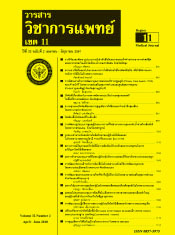เปรียบเทียบการผ่าตัดพังผืดที่ฝ่ามือ (carpal tunnel release) แบบแผลเล็ก (limited incision) และแบบมาตรฐาน แผลใหญ่(conventional incision)
คำสำคัญ:
การผ่าตัดพังผืดที่ฝ่ามือ, การผ่าตัดแบบแผลเล็ก (limited incision), การผ่าตัดแบบมาตรฐาน(conventional incision), scissor, blade, pain scoreบทคัดย่อ
บทนำ : การผ่าตัด limited incision carpal tunnel release เริ่มมีบทบาทในการผ่าตัด พังผืดที่ฝ่ามือเมื่อเทียบกับการผ่าตัดแบบมาตรฐาน conventional incision carpal tunnel release
วัตถุประสงค์: เพื่อเปรียบเทียบผลการรักษาของการผ่าตัดพังผืดที่ฝ่ามือ แบบแผลเล็ก (limited incision carpal tunnel release ) กับการผ่าตัดแบบมาตรฐาน (conventional incision carpal tunnel release)
รูปแบบการศึกษา : การศึกษาเชิงพรรณนาย้อนหลัง โดยรวบรวมข้อมูลคนได้ที่ได้รักการผ่าตัดพังผืดฝ่ามือแบบมาตรฐาน กับการผ่าตัดพังผืดฝ่ามือแบบแผลเล็ก ตั้งแต่เดือนมกราคม 2555–เดือนมกราคม 2558 จำนวน 30 ราย
ผลการศึกษา : การผ่าตัดแบบแผลเล็ก (Limited incision carpal tunnel release) มีอาการเจ็บแผลน้อยกว่า painful scar น้อยกว่ามากอย่างมีนัยสำคัญ (p<0.01) กลับไปทำงานได้เร็วกว่า
สรุปผลการศึกษา : การผ่าตัดแบบมาตรฐาน (conventional incision) มีภาวะแทรกซ้อนการเกิด palmar cutaneous branch of median nerve injuryมากกว่า Limited incision
เอกสารอ้างอิง
J Hand Surg 1992;17A:987–95. [PubMed]
Amadio PC, Silverstein MD, Ilstrup DM, Schleck CD, Jensen LM. Outcome assessment for carpal tunnel surgery :The relative responsiveness of generic,arthritis-specific, disease-specific, and physical examination measures. J Hand Surg 1996;21A:338–46. [PubMed]
Atroshi I, Gummesson C, Johnsson R, Ornstein E, Ranstam J, Rosen I. Preva- lence of carpal tunnel syndrome in a general population. JAMA 1999;282:152– 8. [PubMed]
Brown RA, Gelberman RH, Seiler JG 3rd, Abrahamsson AO, Weiland AJ, Urbaniak JR, Schoenfeld DA, Furcolo D. Carpal tunnel release: A prospective, randomized
assessment of open and endoscopic methods. J Bone Jt Surg 1993;75A:1265. [PubMed]
Chung KC. Commentary: Severe carpal tunnel syndrome. J Hand Surg 2003; 28A:645–46. [PubMed]
Carpal Tunnel Syndrome - Your Ortho- paedic Connection - AAOS”. Orthoinfo. aaos.org. 2009-12-01. Retrieved 2011- 10-05.Outcomes Questionnaire. J Hand
Surg 1998;23A:575–87. [PubMed]
Rodner, Craig M.; Katarincic, Julia. (2006) ”Open Carpal Tunnel Release”. Techniques in Orthopaedics ®21(1):3–11© 2006 Lippincott Williams & Wilkins, Inc.






